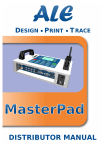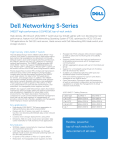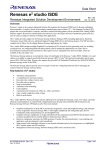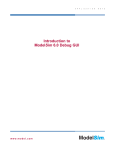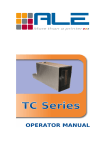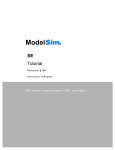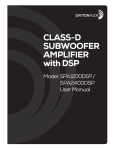Download Operator manual - ALE | More than a printer
Transcript
ALE Design • Print • Trace 03/12/2010 Disclaimer This manual contains instructions for operating the ALE Coral 140 printer. Read it carefully before performing any manipulation. All service operations should be undertaken by qualified personnel only. Contact-us if you need training for our equipment. All information written in this Operator Manual was correct at the time indicated in the version table below. However, the continual enhancement of our products may result in some differences existing between the information contained in this document and your equipment. Copyright © 2010 ALE Sarl, all rights reserved. Reproducing this manual in whole or part without permission is expressly prohibited. RiX® and TraceX® are registered trademarks of ALE sarl. All trademarks in this document belong to their respective owners. Version history: Date: 03/12/10 Revision: First version Coral 144 Operator Manual Modifications: Only solvant version Author: AF i ALE Design • Print • Trace 03/12/2010 Contents Disclaimer i Contents ii Notes iii 1 Description 1 1.1 Print-head description 1 1.2 Numbering 1 1.3 Dimensions 3 1.4 Alarm LEDs 4 2 Start Up 2.1 On line installation 4 4 2.1.1 Defining the position of the system 5 2.1.2 Installing the system along the conveyor 6 2.1.3 Photocell installation 6 2.1.4 Encoder installation 7 2.2 Inking up for the first time "from dry" 2.3 Print-heads alignment 3 Printer operation 8 12 13 3.1 Ink bottle replacement 13 3.2 Printer service 13 4 Controller usage 13 4.1 Change parameters 13 4.2 Make a message 14 Coral 144 Operator Manual ii ALE Design • Print • Trace 03/12/2010 Notes Coral 144 Operator Manual iii ALE Design • Print • Trace 03/12/2010 1 Description 1.1 Print-head description Features: – 142mm print-band – Cyan, Magenta, Yellow and Black colours (CMYK) – print-forward only – uses ALE 250mL ink bottles – 304 Stainless steel enclosure – IEEE1394 data cables (to connect with a MasterSeries controller) Fig. 2: 24x M5 mounting holes underneath On top of the Coral 144 print-head are 8 alarm LEDs. See 1.4 Alarm LEDs for information. 1.2 Numbering Each of the 8 printing channels is numbered (print-engine, Alarm LED, cable, ink reservoir), as Coral144 Operator Manual described by the following drawings. 1 ALE Design • Print • Trace 8 6 1 3 5 7 03/12/2010 2 4 Fig. 3: print-engines numbering (front view) 1 3 5 2 4 1 2 6 3 4 7 8 5 6 7 8 Fig. 4: ink circuits numbering Coral144 Operator Manual 2 ALE 1.3 Design • Print • Trace 03/12/2010 Dimensions The main dimensions are given in the following drawings (Fig. 5). Fig. 5: Coral 144 side dimensions Fig. 6: Coral 144 front dimensions Coral144 Operator Manual 3 ALE Design • Print • Trace 03/12/2010 Fig. 7: Coral 144 bottom dimensions with M5 mounting points 1.4 Alarm LEDs There are eight red alarm LEDs on top of the print-head. Each one corresponds to an ink bottle (See 1.2 for numbering). It starts blinking when the level of ink is too low in the corresponding reservoir, which means that the bottle of ink is empty. Replace it by following the steps described in 3.1.Ink bottle replacement After a configured number of prints, if the ink level is still low in the reservoir, the controller stops the printing (to avoid defective printings). See the controller manual for information on configuring the number of prints after the ink-low signal. When the ink low is detected, the print-head sends an alarm signal to the controller, which can transfer it to an external device such as a PLC. See controller manual for details. 2 Start Up 2.1 On line installation Coral144 Operator Manual 4 ALE 2.1.1 Design • Print • Trace 03/12/2010 Defining the position of the system After unpacking the printer and checking that the contents correspond to your order and to the delivery note, the first operation will be to set the position of the print-head on the conveyor. The correct print-head position can be determined using Codex and its 3D capabilities (Fig. 8). Please refer to the Codex manual for details. Fig. 8: CodeX 3D view with a 72mm print-head You must know that the system must be adjusted so that the surfaces to be printed don't touch the print-head, and are at a maximum distance of 3mm (Fig. 9). Evaluate, then set precisely the product distance several times before “inking up” the printer and printing messages ! We strongly recommend fitting product guide rails. Coral144 Operator Manual 5 ALE Design • Print • Trace 03/12/2010 Don't hesitate to contact your distributor in case you have any questions regarding the position of the printer. 2.1.2 Installing the system along the conveyor Due to the risk of vibration, it is not recommended to fix the printer directly onto the conveyor. Install the controller and connect it to the print-head using the supplied IEEE1394 cables but do not power on. When the final position of the print-head along the conveyor is determined, the next step is to “ink up” the Coral print-head, as it is shipped dry (see next chapter). 2.1.3 Photocell installation Install the supplied photocell close to, but before the print-head. This will detect the product just before it passes the print-head nozzles (Fig. 11) Coral144 Operator Manual 6 ALE Design • Print • Trace 03/12/2010 Fig. 11: Photocell position When installing the photocell ensure that the detection is not confused by reflections, or by poor light or colour contrast. The two LED lights on the photocell should only light once as it detects the passage of the product. If this is not the case, adjust the sensitivity by rotating the little screw either left or right (see manufacturers instructions). 2.1.4 Encoder installation It is recommended to add an encoder to the system if : – the production line has an often varying or automatically varying speed – barcodes are printed. In both cases it is recommended to install the encoder as close as possible from the printing position of the printer along the conveyor, to minimize the elastic effects of the conveyor belt. Information for connecting the encoder to the controller and for operating the encoder can be found in the controller manual. Coral144 Operator Manual 7 ALE 2.2 Design • Print • Trace 03/12/2010 Inking up for the first time "from dry" It is recommended that the printer is removed from the production line during this procedure as there is a risk of ink spillage. Fix the printer to a suitable support. ● Support the Coral print-head to a floor-stand, in printing position. ● With the controller switched off, connect it to the print-head using the data cables from the Coral print-head. ● Remove the air pins from the ink trays (Fig. 12). Those pins prevent leaks from the reservoirs during shipment. Also remove the caps from the reservoirs. Fig. 13: Place a collecting bucket in front of the print-head Fig. 12: Remove air pins and caps ● Place a collecting bucket in front of the print-head (Fig. 13). ● Fit ALE Solvant colour ink bottles in the correct reservoirs SAFETY WARNING! The inks and solvent cleaners are chemical products. In the interests of safety, read the Material Safety Data Sheets carefully before handling the fluids. Always wear protective gloves and eye protection when in contact with any inks or solvents. The Coral 144-S has been specially built to be used with ALE Solvant colour inks. Using any other fluid is likely to severely damage the hydraulic system. Coral144 Operator Manual 8 ALE Design • Print • Trace 03/12/2010 Fitting a bottle of ink into the reservoir: ● Using a craft knife (or a sharp blade), cut the round raised plastic dome on the top of the ink bottle cap (Fig. 14). Turn the bottle up-side down and push into the reservoir (Fig. 15). Fig. 14: Cutting the plastic cap of the ink bottle ● Fig. 15: fitting a bottle Switch the controller on. From this moment, the LCD screen will run through the start up procedure. The controller is ready when the red LED goes off. The default language is English on all new machines. To change the language, please report to the controller's user manual. ● The controller needs to be adjusted to the print-head. To do this, the Setup Wizard is used. It can be accessed from the controller's main screen (Fig. 16). Follow the steps of the Setup Wizard for basic configuration. Please report to the controller's user manual for more information. Fig. 16: MasterPad main screen : access to setup wizard Then the ink system needs to be purged of air. Coral144 Operator Manual 9 ALE Design • Print • Trace 03/12/2010 To prime the system, proceed as follows : ● From the print menu, Press the “Purge” key. It leads to the Purge Menu (Fig. 17). Fig. 17: Master Series prime menu access This menu offers 3 options: – Jet : primes the circuit at high pressure – Test : prints with all nozzles – Norm : primes the circuit at low pressure ● Each print-head has to be primed independently ● To ink up the circuit "from dry" the "Jet" prime is used first (Fig. 18). Fig. 18: MasterPad prime menu ● Press . You should hear the pump “load” (the whirring noise slows down when the pumps fills in with ink) Repeat this operation until ink jets out of the print-engine. WARNING : The pump pressure in “inking up” mode is maximum and ink will jet out!!! ● Prime once more using the "Jet" function to remove air from the ink circuit. ● Prime at least once using the "Normal Prime" function. This is done to remove the remaining air bubbles from the circuit. ● Carefully wipe excess ink off (Fig. 19). Do not touch the nozzle plate : it is coated with a special “non wetting coating” which is self cleaning. Coral144 Operator Manual 10 ALE Design • Print • Trace 03/12/2010 Fig. 19: !! Carefully and gently !! wipe the excess ink ● Check that all dots are operating : prepare a sheet of paper. Then in the Purge Menu, press "blackpad" whilst moving the sheet of paper in front of the print- head. This function prints a solid rectangle of either heads 1 to 4 or 5 to 8 , with no white lines across. Otherwise prime again using the “Normal Prime” option and a bucket (Fig. 13) and check again if all dots are operating. ● When the printing is correct on all print-heads, the collecting bucket can be removed (Fig. 13). ● carefully clean the print-head (Fig. 19). ● Exit the Purge menu of the controller ( ● Set the system for printing back on your production line. ) To make a test print : Hold a piece of paper in front of the print-head. Briefly press "Test Print" and simultaneously pass the piece of paper across right to left. The result should be similar to Fig. 20. Fig. 20: Test message Coral144 Operator Manual 11 ALE 2.3 Design • Print • Trace 03/12/2010 Print-heads alignment Once the printer is inked, it is important to adjust the print engines with respect to each other, to get a perfect print. The x parameter is horizontal. Its value can be changed freely. the y is vertical. For physical reason it can be adjusted between -1 and +1. The Setup Wizard contains 2 screens to do all the alignments: – Inter-Head Align (Fig. 21): a screen to adjust between colours. It allows to adjust between blue and red for example. Fig. 21: Setup Wizard Inter-head Align screen for head 1 (Cyan) – Print-engine Align (Fig. 22) : a screen to make adjustments between 2 print-engines of the same colour. For example if a white line appears in the middle of the print height for the magenta colour, then the y value for Print Engine Align (Head 2) should be decreased (F6) Fig. 22: Setup Wizard printengine Align screen fro head 1 (Cyan) Coral144 Operator Manual 12 ALE Design • Print • Trace 03/12/2010 3 Printer operation 3.1 Ink bottle replacement While the printer is in operation, it is necessary to replace the empty ink bottles before the internal reservoirs go empty as well. The printer reservoirs have an optical ink-low detection mechanism, which will sending warnings just before the reservoirs become empty : it will turn on the red LEDs on top of the printer, and send an ink-low signal to the controller. After a configured number of prints, if the ink level is still low in the reservoir, the controller stops the printing (to avoid defective printings). See the controller manual for information on configuring the number of prints after the ink-low signal. To replace the ink bottle, proceed as follows: – remove the empty ink bottle from the printer – Using a craft knife (or a sharp blade), cut the round raised plastic dome on the top of the new ink bottle cap (Fig. 14). – 3.2 Turn the bottle up-side down and push into the reservoir (Fig. 15). Printer service The printer requires a service every year for routine maintenance and inspection (filters, orings replacement, visual inspection...). Please contact your ALE distributor to have your printer serviced by fully trained staff. 4 Controller usage 4.1 Change parameters All parameters can be modified from the "Settings" screen, which can be accessed from the main screen. Coral144 Operator Manual 13 ALE Design • Print • Trace 03/12/2010 Fig. 23: access to the "Settings" screen All ALE controllers have large memory stores and will accept a large range of character fonts, barcode formats, images and logos. The procedure for loading files into the controllers is detailed in the Codex reference manual. A full explanation of the parameters is detailed in the complete controller manual found in the included CD. This reference manual has over 300 pages of explanation and advices. 4.2 Make a message For instructions on how to make a message, please also read the controller's user manual. Coral144 Operator Manual 14


















